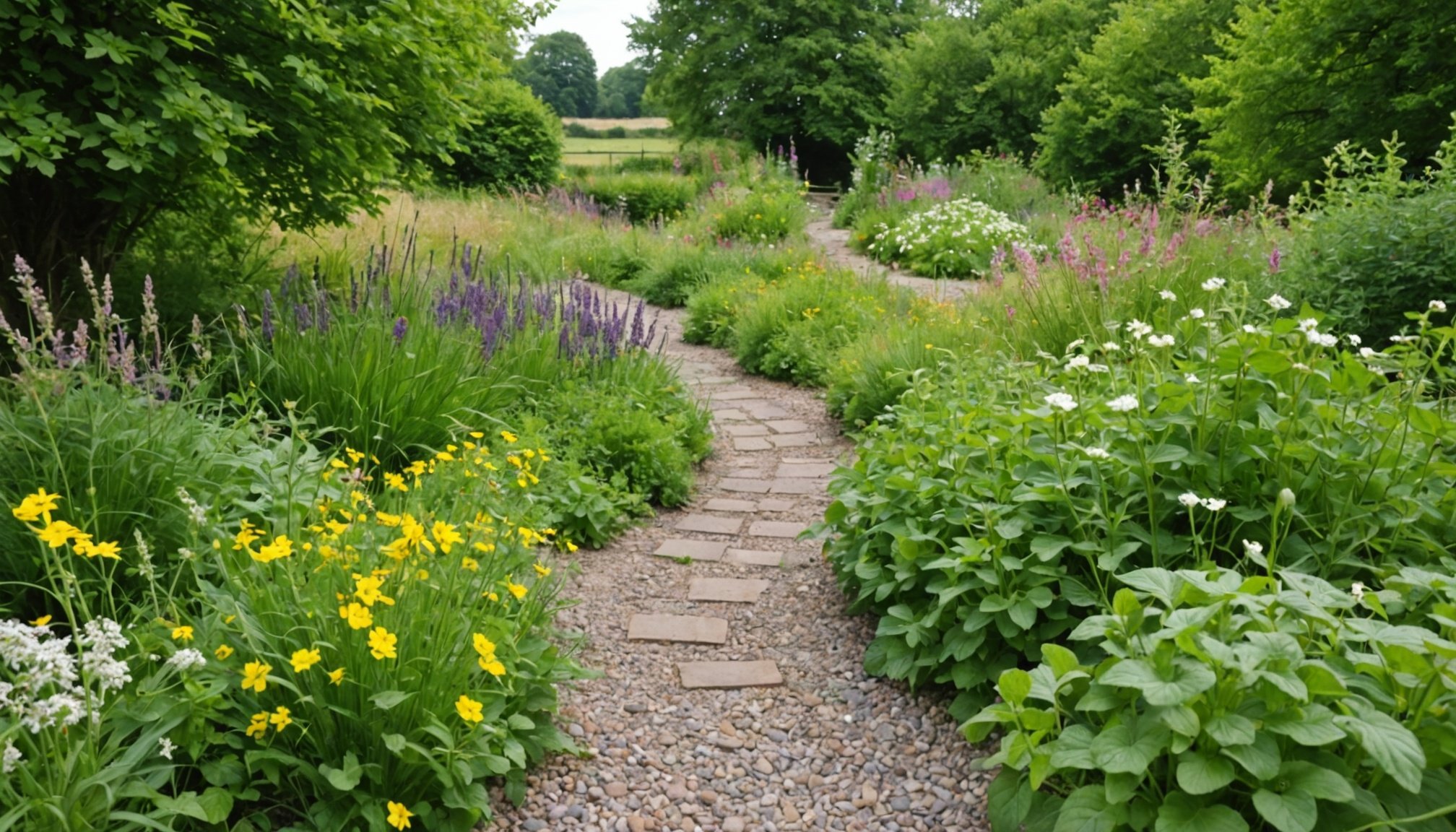Introduction to Organic Weed Management
In the realm of organic weed control, the significance of employing eco-friendly methods cannot be overstated. Organic practices not only safeguard the environment but also promote healthier ecosystems. Gravel pathways in the UK often pose a unique challenge due to their propensity for weed growth, making it essential to adopt sustainable weed management strategies.
One of the primary challenges encountered with UK gravel pathways is their susceptibility to persistent weed infestations. Gravel pathways can inadvertently harbour seeds, providing an ideal environment for their growth. To combat this, gardeners and landscapers must consider methods that align with organic principles, avoiding synthetic herbicides and instead favouring natural remedies.
Also read : Ultimate Guide to Thriving Tomato Cultivation in Your UK Conservatory
Environmentally-friendly practices present several benefits beyond effective weed control. By choosing organic methods, individuals contribute to biodiversity, as these practices often minimise harm to non-target species, including beneficial insects and soil organisms. Additionally, organic weed management methods may improve soil health over time, fostering better plant growth and resilience against future infestations.
For instance, techniques such as manual removal, the use of mulches, and the strategic planting of ground covers can offer practical and sustainable solutions. By embracing these practices, owners of gravel pathways can achieve an effective balance between maintaining aesthetic appeal and supporting ecological health.
Additional reading : Discover the Best Organic Strategies for Controlling Snails in UK Gardens
Boiling Water as a Weed Control Method
Tired of stubborn weeds in your garden? Boiling water weed removal can be a simple and effective solution. Here’s a step-by-step guide to help you tackle this task:
-
Boil Sufficient Water: Start by boiling an ample amount of water in a kettle or pot. Ensure you have enough to cover the affected area thoroughly.
-
Target the Weeds: Pour the boiling water directly onto the weeds. This technique is particularly effective for small-scale infestations and shallow-rooted weeds. The heat damages the plant’s cells, causing them to wither.
-
Repeat as Necessary: Depending on the weed type, multiple applications might be required. Some hardy varieties may need several treatments for complete eradication.
While this method is effective, it’s essential to exercise caution. Boiling water can harm not only weeds but also nearby plants and soil organisms. Thus, it’s crucial to precisely target only the intended weeds to avoid collateral damage.
Safety is paramount. Always wear protective gloves and suitable footwear to prevent burns, and handle boiling water with care to ensure your safety and maintain garden integrity.
With attention to these details, boiling water can be a powerful tool in your weed control arsenal.
Vinegar Solutions for Weeding
Vinegar weed killer serves as an effective organic herbicide, leveraging the power of acetic acid found in household vinegar. This natural herbicide functions by drawing moisture out of the foliage, causing the weeds to wither and die. Its action is most successful when the vinegar weed killer makes direct contact with the plant leaves.
For optimal effectiveness, vinegar concentrations need careful consideration. Household vinegars, typically at 5%, can be used for young, tender weeds. However, more stubborn weeds may require higher concentrations, such as horticultural vinegars with up to 20% acetic acid. It’s essential to exercise caution due to the increased potency, which can have adverse effects not only on undesired plants but potentially on nearby desirable flora as well.
Application strategies can help reduce unintended damage. Target the weeds by applying vinegar in spot treatments. A common method is using a spray bottle for controlled delivery to affected areas. Furthermore, applying on a sunny day can amplify effectiveness, as the combination of sunlight and vinegar’s acetic acid hastens the drying effect. Protecting surrounding plants can be achieved by shielding them with barriers, ensuring the organic herbicide focuses solely on the weeds you aim to eliminate. These careful application techniques contribute to a successful and mindful approach to weeding.
Mulching Techniques to Suppress Weeds
Employing effective mulch application is a key strategy in keeping gravel pathways free from weeds. Various types of mulch serve this purpose, with organic options like wood chips, bark, and compost leading the charge. These materials not only suppress undesired growth but also contribute to soil health. Inorganic alternatives, such as landscape fabric topped with decorative gravel, provide a lasting solution due to their durability.
Beyond simply keeping weeds at bay, mulching offers additional benefits. Organic mulch enhances nutrient exchange as it decomposes, fostering a nutrient-rich environment for surrounding plants. It also helps to retain moisture in the soil, thus reducing the need for frequent watering.
When applying mulch, precision is crucial. Begin by clearing the area of existing weeds. Ensure a layer about 2-3 inches deep; too little may allow light to reach the soil, encouraging weeds. Be cautious not to smother plant bases, which may inhibit growth. Consistent maintenance, including regular replenishment of mulch, preserves its effectiveness against weed growth.
Applying mulch correctly not only addresses the immediate need for weed suppression but also enriches the landscape, making it a doubly advantageous practice. With mindful application and upkeep, you can benefit from a weed-free and aesthetically pleasing pathway.
Hand Pulling and Hoeing Strategies
Manual weed removal is an effective way to maintain a healthy garden and landscape. When hand pulling weeds, it is crucial to do so with precision and care to ensure the entire root system is removed. This not only prevents the weed from regrowing but also helps in maintaining soil health. Aim to remove the weeds when the soil is moist, as this makes it easier to pull them out completely. Using gloves can protect your hands from thorns and irritants.
Regular hoeing for weeds is another effective strategy. Hoeing is best done on dry, sunny days to ensure the uprooted weeds wither and die. It’s important to angle your hoe slightly beneath the soil surface to cut weeds at the base, thereby disrupting their growth. Regular maintenance through hoeing not only eliminates current weeds but also hinders their chances of regrowing.
Routine care and attention to these methods help ensure a weed-free environment. Regular inspection is a must and consistent removal of weeds before they seed is the optimal approach. A persistent and vigilant attitude toward these manual weed removal strategies will support the overall health and appearance of your garden. Investing time in these methods ensures vibrant plant life and robust growth, free from unsightly intruders.
Preventive Measures for Long-term Control
Creating a gravel pathway that inherently minimizes weed growth requires a multifaceted approach. Begin with a solid foundation by installing a barrier fabric beneath the gravel to impede weed seed germination. Selecting gravel that compacts well can also discourage weeds by reducing gaps where they might take root.
Gravel pathway maintenance is crucial in sustaining a weed-free environment. Regular inspections help identify initial weed intrusions. Addressing these promptly with hand-pulling or spot treatment ensures they don’t establish a substantial foothold. A monthly routine is beneficial, where gardeners can assess and rectify minor issues before they escalate.
In the UK, adapting to the seasonal climate is essential for effective weed control. Spring and autumn are prime for implementing preventive measures and rejuvenating barriers like mulch. Seasonal shifts can provide opportunities for weed growth, so adjusting maintenance techniques accordingly enhances the pathway’s resilience.
The integration of weed prevention strategies with an appreciation for the surrounding environment empowers homeowners to manage their spaces effectively. By understanding how British weather impacts weed proliferation, individuals can tailor their maintenance schedule to align with climatic patterns, ensuring their pathways remain pristine and functional throughout the year.
Alternative Organic Solutions
Exploring organic weed solutions can be both eco-friendly and effective. Many commercially available products now provide natural ingredients aimed at weed control without the harsh chemicals often found in traditional options. When selecting an organic solution, consider factors such as the type of weeds you are dealing with, the area size, and long-term environmental impact. Eco-friendly products are typically designed to break down quickly, reducing harm to the soil and surrounding plants, making them a preferred option for environmentally conscious gardeners.
Several organic solutions include vinegar-based sprays, corn gluten meal, and soap-based herbicides. These products often rely on natural acids and oils that dehydrate and break down the weeds’ protective layers without damaging soil health. When choosing a product, check if it’s suitable for your garden’s specific climate and weed species to ensure greater control.
Combining different organic methods can enhance their effectiveness. For instance, using a vinegar spray in conjunction with mulching can suppress weed growth while maintaining moisture for desirable plants. Mulching itself can act as a physical barrier, while manual removal ensures precision. By integrating multiple methods, one can create a more robust strategy for weed management, tailoring approaches to suit specific gardening requirements.
Conclusion and Recommendations
Reflecting on the techniques discussed, adopting effective weed management strategies in your garden can significantly enhance its health and productivity. By leveraging organic gardening tips, you not only foster a thriving environment but also contribute to ecological balance.
Among the key strategies are:
-
Mulching: This technique not only controls weeds but also conserves soil moisture, providing a dual benefit.
-
Companion planting: This method maximizes space while naturally deterring pests, promoting a healthier garden ecosystem.
-
Manual removal: Though labor-intensive, hand-pulling is effective in ensuring that no chemicals disturb your garden’s natural state.
We urge you to explore these eco-friendly practices, integrating them into your gardening routines where feasible. Not only are these methods sustainable, they are also often more cost-effective in the long run compared to chemical alternatives.
Feel empowered to share your personal experiences and insights with organic gardening methods. By exchanging knowledge and tips, you can help build a community dedicated to eco-conscious gardening practices. Personal stories and successes can serve as inspiration to others embarking on their own organic gardening journey.
Together, we can contribute to a healthier planet, one garden at a time, paving the way for a sustainable future.











